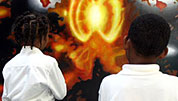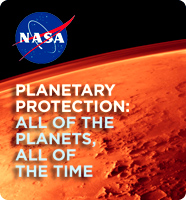-
NOVA ScienceNOW - Hunt for Alien Earths
NOVA’s ScienceNOW series, hosted by Neil de Grasse Tyson, has just released a new episode called Hunt for Alien Earths which is devoted to the work of astronomers who search for planets orbiting other stars that might host life. Astrobiologists Lisa Kaltenegger, David Charbonneau, and Geoff Marcy are featured in this beautifully produced, twelve minute video.
-
Invisible Yellowstone
Research conducted in Yellowstone National Park by astrobiologists from NAI’s Montana State Team is highlighted in the 30-minute film Invisible Yellowstone, produced by MSU’s Thermal Biology Institute and MSU’s Science and Natural History filmmaking program. The film is available on DVD by contacting Daniella Scalice at daniella.m.scalice@nasa.gov
-
Summer Workshops for Teachers in Astrobiology

Every summer, NAI teams and others host hands-on, in-the-field, in-the-lab workshops for educators. The workshops feature cutting edge astrobiology research delivered by astrobiology scientists and education professionals, as well as inquiry- and standards-based activities ready for your classroom. Below is a current list of offerings for Summer 2009:
Earth’s History: Interaction Between Life and the Environment
Produced by: Pennsylvania State University
Workshop Dates: 28 June – 2 July, 2009
Workshop... -
Virtual Field Trip to Western Australia

Visit the Mars analogue sites in Western Australia without leaving home!
Within the virtual field trip application, users are taken from a global view directly down to a surface view of a site. They are then seamlessly placed into a 360 degree spherical virtual reality surface panorama of that location. Next users navigate around the site selecting various objects and scientists to learn more about how and why this site was chosen,...
-
Astrobiology Career Path Suggestions
List of current astrobiology career and educational opportunities
Astrobiology is the study of the origins, evolution, distribution, and future of life in the universe. This interdisciplinary field requires a comprehensive, integrated understanding of biological, planetary, and cosmic phenomena. Astrobiology encompasses the search for habitable environments in our Solar System and on planets around other stars; the search for evidence of prebiotic chemistry or life on Solar System bodies like Mars, Jupiter’s moon Europa, and Saturn’s moon Titan; and research into...
-
Life on Earth....and Elsewhere?

This booklet, originally produced by NAI in 2000 and updated in 2007, contains five inquiry- and standards-based classroom activities for grades 5-8 and three math extensions spanning topics from Defining Life, to Determining the Chances of Extraterrestrial Life.
One of the activities, What Makes a World Habitable? utilizes Habitability Cards to investigate the possibility of life elsewhere in the Solar System.
-
micro*scope

The study of microbial communities is essential if we are to understand and manage the world around us, and such studies prepare us for the exploration for life on other planets. micro*scope has images of microbes, classification schemes, descriptions of organisms, talks, and other educational resources to improve awareness of the biodiversity of our microbial partners.
-
Astrobiology Education Poster

With gorgeous graphics, supporting background reading, and three inquiry- and standards-based, field tested activities, this poster is a great addition to any middle or high school classroom. It explores the connection between extreme environments on Earth, and potentially habitable environments elsewhere in the Solar System.
Astrobiology Education Poster small (PDF) large (PDF)
Science Background Text (PDF)
Activity 1 Life: What is it? Where is it? (PDF)
Activity...
-
Yellowstone National Park Guide to Life in Extreme Heat

Chapter 4 of the Yellowstone Resources and Issues Guide, called Life in Extreme Heat, describes thermophiles, their habitats in the Park, and their relationship to both the history of life on Earth, and the search for life elsewhere. The Guide is used to train Park naturalists and rangers, and it can also serve as a valuable resource when teaching about extremophiles and astrobiology in the classroom. Chapter 4 can be downloaded from
-
Voyages Through Time

Voyages Through Time (VTT) is an integrated science curriculum for ninth or tenth grade based on the theme of evolution and delivered on CD-ROM. It’s six modules span the breadth of astrobiology research, from cosmic evolution through the evolution of life, and beyond. In VTT, evolution is defined as cumulative change over time that occurs in all realms of the natural world. The evolutionary scope of VTT is billions...
-
Looking for Life TV Documentary

NAI scientists and their international partners are featured in a new documentary called Looking for Life which has aired both on PBS and NASA-TV. The program highlights cutting edge field work in the arid Western Australian desert, an acidic river in Spain, high altitude lakes in the Bolivian Andes, and the permafrost within an old gold mine in the Canadian Arctic where astrobiologists are characterizing the unique habitats and survival...
-
Astrobiology, An Integrated Approach

TERC has developed a middle and high school curriculum that stimulates student learning and participation with intriguing questions and illuminating activities. Astrobiology, by its very nature, kindles interest and curiosity in students and offers a genuinely exciting entrée to high school science. The yearlong curriculum is an inquiry-based, interdisciplinary program of study. Through a series of hands-on activities, students explore diverse concepts in chemistry, physics, biology, and Earth and space science. These...
-
Take a Ride Through a Microbial Mat!

What would it be like to actually be inside a microbial mat? Take a ride on the Stromatolite Explorer as it explores the layers and interactions within a mat. The animated short (7 minute) video, Stromatolite Explorer, uses computer animation and video microscopy to take you on an imaginary tour inside a microbial mat.
-
Microbes@NASA

Microbes@NASA is a website loaded with fantastic teaching tools for educators about microbial mats and why NASA is interested in them. Explore the site for a photo gallery, interactive web features in which students can conduct remote experiments on a real microbial mat in a NASA laboratory, numerous classroom activities, and a 7 minute animated film taking you for a ride through a microbial mat (teacher guide included).
-
Astrobiology Book for Young Readers

Lerner Publishing Group has published a new Cool Science title for 4-8th grade readers called Astrobiology. From early imaginings about life on the Moon to modern observations of Mars, Europa, and Titan, this book gives an easy to follow, historical context for the search for life elsewhere.
The book’s author, Dr. Fred Bortz, engages students directly through school visits and other events.
-
Exploring Deep Subsurface Life

Exploring Deep Subsurface Life Workbook and DVD teaching materials focus on research sites at Harmony Gold Mine in South Africa, and Lupin Gold Mine and High Lake Mine in Nunavut Territory, Canada. The workbook’s imagery invites the audience into the mine sites, and the lessons correspond to the astrobiology research carried out in the deep subsurface. The video and animation materials support and compliment the lessons in the workbook and introduce the...
-
Explore Saturn's Moon Titan

New imagery and data from NASA’s Cassini-Huygens mission have “lifted the veil” enshrouding Saturn’s moon Titan, revealing what lies beneath its dense atmosphere. Explore this visually stunning, interactive, multimedia web feature for an overview of the mission, a comparison of Earth and Titan, a 3D globe of Titan, and the latest images from Cassini.
-
Microbial Life Educational Resources

Microbial Life is a freely accessible digital library dedicated to the diversity, ecology, and evolution of the microbial world. Engage students with hands-on activities and other curriculum-based resources that cover topics such as astrobiology, bioinformatics, extremophiles, and the microbes of marine environments.
The site contains a variety of educational and supporting materials for students and teachers of microbiology. You will find information about microorganisms, extremophiles and extreme habitats, as well as links...
-
Explore Saturn's Moon Enceladus

This web interactive from NASA’s Cassini mission features dazzling new imagery of Saturn’s moon Enceladus. It details the discovery of the plumes of ice particles and water vapor erupting from the surface and extending hundreds of kilometers into space. These plumes have put Enceladus on the map as an object of astrobiological study.
-
Astro-Venture

Astro-Venture is an educational, interactive, multimedia Web environment highlighting NASA careers and astrobiology research in the areas of Astronomy, Geology, Biology and Atmospheric Science. Students in grades five through eight are transported to the future where they role play NASA occupations and use scientific inquiry, as they search for and build a planet with the necessary characteristics for human habitation. Supporting activities include chats with real NASA scientists, online collaborations,...




